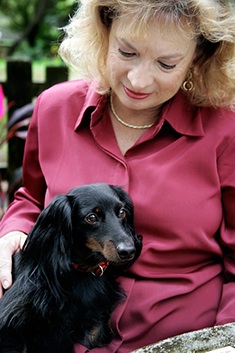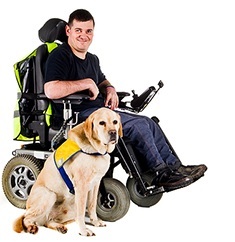Therapy Dogs
The term “therapy dog” can apply to a dog in a wide variety of situations. These dogs may work in hospitals, schools, rehabilitation facilities, and / or disaster areas. They enjoy giving comfort to strangers and must be willing to be treated less than gently by all sorts of people. Their main function is to allow people to feel comfortable making physical contact with another living being.
What dogs make good therapy dogs?
Any breed or size of dog may become a therapy dog, provided he has the proper temperament. The job qualifications include friendliness, patience, and confidence in strange situations.

The dog should be able to climb onto laps and hospital beds, but if he is too little for this, his handler can lift him up. He must be capable of sitting still and allowing the person to pet and handle him, even if the person has disabilities that make it difficult for him to be gentle with the dog. Some people with disabilities may move with unpredictable and “jerky” motions. The dog must be able to handle this without being scared or running away.
The dog must be trained or naturally inclined to keep all four feet on the floor, rather than jumping up to meet his new friends. In addition, he should not be a kisser, as many people do not appreciate dog kisses.
How were therapy dogs developed?
The earliest references to a therapy dog are from World War II, when a Yorkie named Smoky was sold to Corporal William A. Wynne for the price of a poker game stake. When Corporal Wynne was later hospitalized, his friends brought Smoky to visit. Charmed with the little dog, commanding officer Dr. Charles Mayo (of Mayo Clinic fame) allowed Smoky to travel the hospital freely, cheering up the recovering soldiers and sleeping at night in Wynne’s bed.

Elaine Smith, an American registered nurse who worked in England in the mid-20th century, was taken by the response of patients to visits by a chaplain and his Golden Retriever. When Ms. Smith came back to the States in the mid-70’s, she started what is believed to be the first training program for therapy dogs.
Over the years, dogs have been shown to promote healing by reducing anxiety levels, lowering blood pressure, and raising the patients’ spirits. In fact, one recent study found that the presence of therapy dogs reduced agitation and increased socialization among patients with Alzheimer’s disease.(1) As the demand for therapy dogs has expanded, the concept has been broadened to include other animals such as cats, rabbits, and birds.
Are therapy dogs the same as assistance dogs?
Therapy dogs serve a very different function than assistance dogs. Assistance dogs are typically trained to do very specific tasks to help one specific person with disabilities function in a world designed for fully-able people, while therapy dogs are more generally trained to provide comfort to anyone who needs it.
Therapy dogs are therefore not covered by the same laws that permit service dogs entry into just about any environment. For example, the Americans with Disabilities Act of 1990 specifies that assistance dogs be allowed into restaurants, plane cabins, and other places where dogs might not typically be allowed. However, no such protection exists for therapy dogs, and any institution may choose to prohibit or limit their access.

Hospitals, schools, and other places that do invite therapy dogs usually have specific requirements the dog must meet prior to admittance. If you are considering using your dog as a therapy dog, you will likely be required to provide evidence that the dog has passed the American Kennel Club’s Canine Good Citizen test. Such certifications assure that a dog is not frightened into aggression by sudden noises, assistance devices like wheelchairs or walkers, small rowdy children, or the machinery often present in hospitals.
What organizations are there for therapy dogs?
Three main organizations in the United States are involved in the training, certification, and support of therapy dogs. The Delta Society of Bellevue, Washington, envisions a “world in which people are healthier and happier because companion, therapy and service animals share our everyday lives.” They seek to educate health care professionals and others about the healing powers of animals by advancing research to demonstrate how animals positively impact human lives. They also facilitate the “effective incorporation of animals into professional practices to improve people’s lives.”
The Alpha Society, located in various cities throughout the United States, “is a non-profit, all-volunteer, charity foundation that brings together our highly trained and certified Therapy Dog and Handler Teams with special populations.” Their handlers take dogs to nursing homes, hospitals, schools, and “just about anywhere that the bond between animal and people can perpetuate hope and joy.”
Therapy Dogs International is “a volunteer organization dedicated to regulating, testing and registration of therapy dogs and their volunteer handlers for the purpose of visiting nursing homes, hospitals, other institutions and wherever else therapy dogs are needed.” Founded in New Jersey, TDI now boasts dog/handler teams in all 50 states and in Canada.
How is a dog certified to be a therapy dog?
Different organizations require different qualifications for certification, but this pass/fail checklist from TDI is a good general indicator of the requirements for both the dog and the handler.
- How does the dog respond when requested to perform a task? Is he/she happy to comply? Does he/she show signs of confusion, stress or not respond quickly or maybe not at all?
- Does the dog seem comfortable with the handler? Does he/she show signs of confusion, stress or not respond quickly or maybe not at all?
- Can the dog obey commands reliably around other dogs without the handler having to repeat them and without paying more attention to the other dog rather than the handler?
- Does the dog accept petting willingly with no shyness, fear or aggression?
- Is the dog willing to be petted for long periods of time without agitation, stress or fear?
- Is the dog willing to be hugged or petted with a “heavy hand” by persons of all ages?
- Does the dog startle to: sounds, wheelchairs, canes, people walking with an uneven gait, loud & obnoxious people, screaming kids & crowded places?
- Does the dog seem comfortable when separated from its owner (owner out of sight) while the dog is under the control of the evaluator?
- Does the handler possess good handling skills—has the dog on a loose leash & in complete control?
- Does the handler know when the dog is stressed & respond appropriately?
- Does the handler know how to handle the dog if it shows signs of stress?
- Does the handler know how to keep his/her dog happy & upbeat about the task being performed or requested?
- Do the handler and dog have an obvious understanding & work well as a team?
- Does the handler seem stressed or nervous?
- Does the handler get frustrated easily if the dog doesn’t comply?
- How does the handler handle the dog if he/she is not responding well?
- Is the handler calm & comfortable at all times?
- Is the handler in tune with the dog as well as his/her surroundings?
In addition to these performance requirements, all dogs who want to participate in therapy must meet certain health requirements, such as these listed by TDI:
- Annual Check-up attested to by your veterinarian within the past year.
- Mandatory Rabies Vaccine given by a veterinarian.
- An initial series of core Distemper, Hepatitis, and Parvovirus Vaccinations.
- A negative Fecal Exam within the past year.
- A negative Heartworm test within the past year unless there is no heartworm present in the area or if the dog is on preventative medication.
Finally, the facility where the therapy dog goes to visit may have certain requirements including increased grooming frequency and specific halters or leads.
For more information, be sure to check out our article on Therapy Dog Training
(1) Churchill, M.; Safaoui, J.; McCabe, B.W.; Baun, M.M. Using a Therapy Dog to Alleviate the Agitation and Desocialization of People with Alzheimer’s Disease. Journal of Psychosocial Nursing and Mental Health Services 37(4): 16-22, April, 1999.
Doggies Den: Latest Articles
 Homemade Thanksgiving Treats for Your Dog
Homemade Thanksgiving Treats for Your Dog
NUTRITION We all want to include our dogs in our holiday celebrations, but hopefully, you're aware that sharing table scraps with your dog isn't always the best idea.
 Keeping Your Dog Safe during the Summer Months
Keeping Your Dog Safe during the Summer Months
HEALTH Summer is coming on fast, so it’s time to plan how you will keep your dog safe and healthy through the lazy, carefree, warm days.
 Vaccination Time Again-Keeping Your Puppy Healthy
Vaccination Time Again-Keeping Your Puppy Healthy
DOG HEALTH So you have your new puppy picked out. There are quite a few shots, treatments and examinations that will keep the newest member of your family healthy.
 Canine Thanksgiving Feast
Canine Thanksgiving Feast
NUTRITION With the wide variety of food at Thanksgiving dinner, chances are you'll want to give your dog something special, too. If you're contemplating what to feed your dog for the holiday, here is a guide to a great Canine Thanksgiving Feast.
 Dog Walking Tips Every Owner Should Know
Dog Walking Tips Every Owner Should Know
DOG FUN Walking your dog is not only crucial to keeping him healthy and happy, it strengthens the bond between your canine friend and his caregiver. There are a lot of obstacles out there. Don’t forget these simple tips to keep your walk fun and safe in the outside world.
 The Benefits of Physiotherapy for your Dog
The Benefits of Physiotherapy for your Dog
HEALTH The same techniques that physiotherapists use to treat a variety of injuries and conditions in humans have been adapted to suit animals with great success. Family pets, show dogs, and working dogs can all benefit greatly from physiotherapy. Dogs whose activities involve a lot of agility are especially susceptible to the types of problems that physiotherapy can address.
 The Decision- Adding a Dog to Your Family
The Decision- Adding a Dog to Your Family
FIRST TIME OWNERSBringing a dog into your family is a decision where many people don’t realize it’s magnitude until after they have the dog. There are a number of things that you need to research before you decide to purchase a dog, and it starts right in your own home.
 Bringing Your Dog Into Your New Baby's Life
Bringing Your Dog Into Your New Baby's Life
HEALTH Many believe that a dog and a new baby cannot happily coexist, so therefore the dog has to go. This is not necessarily the case.  A new baby does not mean you have to abandon your dog.

Doggies Den:
Most Popular Articles

Dog Pregnancy Symptoms
HEALTHIf you suspect your dog might be pregnant, check out part one in this series on pregnant dogs, where we cover pregnant dog symptoms.

Dog Birth
HEALTHIn the third article of our dog pregnancy series, we look at the wonderful, but messy, process of bringing newborn puppies into the world.

Indoor Dog Potties
DOG PRODUCTSIt's been a long day at work. You were so busy, you didn't even take time to eat a sandwich, let alone run home to let your dog out. You're on your way home, knowing the poor dog is crossing his or her legs by now, when your car breaks down, delaying you even further. Can't somebody make this easier?

Your Dog’s Digestive System
PHYSIOLOGYEver wonder why your dog eats so fast? Or why he eats gross things? Or why he gets sick to his stomach? Or why his waste stinks so bad? Some of these things are normal, some are not.

Canine Respiratory System
BREATHINGThe basic function of your dog's respiratory system is to bring oxygen in to and remove carbon dioxide from the body. Knowing the symptoms of respiratory diseases can help you help your stay healthy.

Shelter Dog Adoption Tips for Success
ADOPTION Are you intimidated by the prospect of "rescuing" a dog from a shelter? One reason that you may be wary of adopting a dog from a shelter is not knowing how to choose. Adopting a dog from a shelter can be a rewarding process, if you're prepared to do a reasonable amount of research.

Canine Urinary Tract Infections
SYMPTOMS AND TREATMENTDoes your dog seem to be having trouble relieving his or her bladder? Learn how to recognize the signs of urinary tract infections and how to treat them before they spread.

What to do for Dog Diarrhea
SYMPTOMS AND REMEDIESIf you have dogs in your house for any length of time, you have likely experienced at least one bout of dog diarrhea. Beyond the pain in the tuckus involved in cleaning up the mess, you should know what causes diarrhea, and when it's important to see the vet.

What to do for a Dog Bite
DOG BEHAVIOR Getting bitten by a dog can be scary, and you may be tempted to run around in circles for a while, trying to figure out what to do. Here's our guide to help you manage the situation.

Top Ten Tips for Living with a Senior Dog
DOG HEALTH Bringing home a new puppy is so exciting, but it doesn’t take all that long for your exuberant puppy to grow into a senior dog who may have special needs. Here are the doggies.com top ten tips for taking care of your companion who has been with you through so much.
